Douglas DC-2
| DC-2 | |
|---|---|
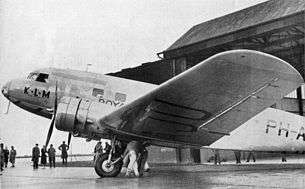 | |
| DC-2 PH-AJU Uiver came second in the MacRobertson Air Race | |
| Role | Passenger & military transport |
| Manufacturer | Douglas Aircraft Company |
| First flight | May 11, 1934 |
| Introduction | May 18, 1934 with Trans World Airlines |
| Status | Retired |
| Primary users | Transcontinental & Western Air (TWA) KLM Pan American Airways |
| Produced | 1934–1939 |
| Number built | 198 |
| Developed from | Douglas DC-1 |
| Developed into | B-18 Bolo Douglas DC-3 |
The Douglas DC-2 is a 14-seat, twin-engined airliner that was produced by the American company Douglas Aircraft Corporation starting in 1934. It competed with the Boeing 247. In 1935, Douglas produced a larger version called the DC-3, which became one of the most successful aircraft in history.
Design and development
In the early 1930s, fears about the safety of wooden aircraft structures drove the US aviation industry to develop all-metal airliners. United Airlines had exclusive right to the all metal twin-engine Boeing 247; rival TWA issued a specification for an all-metal trimotor.
The Douglas response was more radical. When it flew on July 1, 1933, the prototype DC-1 had a robust tapered wing, retractable landing gear, and two 690 hp (515 kW) Wright radial engines driving variable-pitch propellers. It seated 12 passengers.
TWA accepted the basic design and ordered twenty of the upgraded DC-2s which were longer, had more powerful engines, and carried 14 passengers in a 66-inch-wide cabin. The design impressed American and European airlines and further orders followed. Although Fokker had purchased a production licence from Douglas for $100,000, no manufacturing was done in Holland. Those for European customers KLM, LOT, Swissair, CLS and LAPE purchased via Fokker in the Netherlands were built and flown by Douglas in the US, sea-shipped to Europe with wings and propellers detached, then erected at airfields by Fokker near the seaport of arrival (e.g. Cherbourg or Rotterdam).,[1] Airspeed Ltd. took a similar licence for DC-2s to be delivered in Britain and assigned the company designation Airspeed AS.23, but although a registration for one aircraft was reserved none were built.[2] Another licence was taken by the Nakajima Aircraft Company in Japan; unlike Fokker and Airspeed, Nakajima built five aircraft as well as assembling at least one Douglas-built aircraft.[2] A total of 130 civil DC-2s were built with another 62 for the United States military. In 1935 Don Douglas stated in an article that the DC-2 cost about $80,000 per aircraft if mass-produced.[3]
Operational history
Although overshadowed by its ubiquitous successor, it was the DC-2 that first showed that passenger air travel could be comfortable, safe and reliable. As a token of this, KLM entered its first DC-2 PH-AJU Uiver (Stork) in the October 1934 MacRobertson Air Race between London and Melbourne. Out of the 20 entrants, it finished second behind only the purpose-built de Havilland DH.88 racer Grosvenor House. During the total journey time of 90 hours, 13 min, it was in the air for 81 hours, 10 min, and won the handicap section of the race. (The DH.88 finished first in the handicap section, but the crew was by regulations allowed to claim only one victory.) It flew KLM's regular 9,000 mile route, (a thousand miles longer than the official race route), carrying mail, making every scheduled passenger stop, turning back once to pick up a stranded passenger, and even became lost in a thunderstorm and briefly stuck in the mud after a diversionary landing at Albury racecourse on the very last leg of the journey.[4]
Variants
Civilian

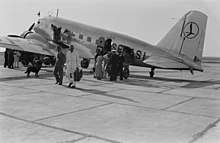
- DC-2
- 156 civil DC-2s, variously powered by two Wright R-1820-F2 -F2A -F3 -F3A -F3B -F52 -F53 Cyclone radial piston engines varying in power from 710 to 875 hp (529 to 652 kW).
- DC-2A
- Two civil DC-2s, powered by two Pratt & Whitney R-1690 Hornet SD-G, S1E-G or S2E-G radial piston engines.
- DC-2B
- Two DC-2s sold to LOT Polish Airlines, fitted with two 750 hp (560 kW) Bristol Pegasus VI radial piston engines.[5]
- Nakajima-Douglas DC-2 Transport
- DC-2 transports license built in Japan by Nakajima.
- Airspeed AS.23
- The designation reserved for proposed license-built production by Airspeed Ltd. in Great Britain.
Military
Modified DC-2s built for the United States Army Air Corps under several military designations:
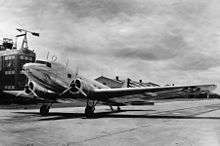
- XC-32
- (DC-2-153) One aircraft, powered by 2x 750 hp (560 kW) Wright R-1820-25 radial piston engines, for evaluation as a 14-seat VIP transport aircraft, one built,[6] later used by General Andrews as a flying command post.[7]
- C-32A
- Designation for 24 commercial DC-2s impressed at the start of World War II.[6]
.jpg)
- C-33
- (DC-2-145) Cargo transport variant of the C-32 powered by 2x 750 hp (560 kW) Wright R-1820-25 engines, with larger vertical tail surfaces, a reinforced cabin floor and a large cargo door in the aft fuselage, 18 built.[6]
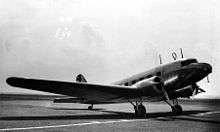
- YC-34
- (1x DC-2-173 & 1x DC-2-346) VIP transport for the Secretary of War, basically similar to XC-32, later designated C-34, two built.[8]
- C-38
- The first C-33 was modified with a DC-3 style tail section and two Wright R-1820-45 radial piston engines of 975 hp (727 kW) each. Originally designated C-33A but redesignated as prototype for C-39 variant, one built.[9]
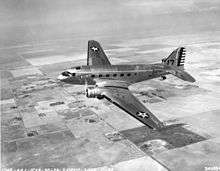
- C-39
- (DC-2-243) 16-seat passenger variant, a composite of DC-2 & DC-3 components, with C-33 fuselage and wings and DC-3 type tail, center-section and landing gear. Powered by two 975 hp (727 kW) Wright R-1820-45 radial piston engines; 35 built.[10]
- C-41
- The sole C-41 was a VIP aircraft for Air Corps Chief Oscar Westover(and his successor Hap Arnold ).Although supplied against a C-39 order it was not a DC-2 derivative but in fact a DC-3-253 fitted with two 1,200 hp (890 kW) Pratt & Whitney R-1830-21 engines. (The sole Douglas C-41A was also a VIP version of the DC-3A)[11]
_Big_Chief_front_view.jpg)
- C-42
- (DC-2-267) VIP transport variant of the C-39, powered by two 1,000 hp (750 kW) Wright R-1820-53 radial piston engines, of 1,000 hp (746 kW) each, one built in 1939 for the commanding general, GHQ Air Force, plus two similarly-converted C-39s with their cargo doors bolted shut were converted in 1943.[11]

- R2D-1
- (3x DC-2-125 & 2x DC-2-142) 710 hp (530 kW) Wright R-1820-12 powered transport similar to the XC-32, three built for the United States Navy and two for the United States Marine Corps.
Operators
♠ = Original operators
Civil operators
- Australian National Airways
- Holymans Airways ♠
- CNAC, jointly owned and operated with Pan American Airlines
- ČLS (Československá Letecká Společnost, Czechoslovak Air Transport Company) ♠
- KNILM (Royal Netherlands Indian Airways) ♠
- Great Northern Airways ♠
- Japan Air Transport
- Imperial Japanese Airways
- Manchurian Airlines
- KLM ♠ ordered 18 aircraft.
- LOT Polish Airlines ♠ operated three DC-2B aircraft between 1935 and 1939
- Líneas Aéreas Postales Españolas ♠ received five aircraft.
- Swissair ♠
- American Airlines ♠
- Braniff Airways
- Delta Air Lines operated four aircraft during 1940–1941
- Eastern Air Lines ♠ received 14 aircraft and used them on East Coast routes.
- General Air Lines ♠
- Mercer Airlines ♠ 1 airplane, sold to Colgate Darden in late 1960s, now in the Netherlands
- Pan American Airways ♠ received 16 aircraft, distributing many to its foreign affiliates; some flew under its own name on Central American routes.
- Pan American-Grace Airways (Panagra) ♠ used its DC-2s on routes within South America.
- Transcontinental & Western Air (TWA) was the first DC-2 operator, receiving 30 aircraft. ♠
- PLUNA operated two DC-2s acquired from Panair do Brasil.
Military and government operators
- Argentine Naval Aviation - 5 (+1) DC-2 ex civilian Venezuelan [12]
- Royal Australian Air Force - Ten aircraft were in service with the RAAF from 1940 to 1946.
- No. 8 Squadron RAAF
- No. 36 Squadron RAAF
- Parachute Training School RAAF
- Wireless Air Gunners School RAAF
- Austrian Government
- Finnish Air Force Donated by the Swedish military during the Winter War (1939-1940) which flew a bombing mission based on Tampere on 22 February 1940
- French government
- Regia Aeronautica 2 aircraft[13]
- Imperial Japanese Army Air Service - A single example of the DC-2 was impressed by the Imperial Japanese Army.[14]
- Spanish Republican Air Force took over the DC-2s from LAPE inventory.[15]
Incidents and accidents
- December 20, 1934
- A KLM DC-2-115A (PH-AJU, Uiver) crashed at Rutbah Wells in Iraq, killing all seven on board. The aircraft was operating a flight from Schiphol to Batavia.[16][17] This was the first loss of a DC-2 and the first fatal accident involving the DC-2.
- May 6, 1935
- TWA Flight 6, a DC-2-115 (NC13785), crashed near Atlanta, Missouri due to navigation errors, killing five of eight on board; New Mexico Senator Bronson M. Cutting was among the dead.[18]
- July 20, 1935
- A KLM DC-2-115E (PH-AKG, Gaai) crashed on landing at Pian San Giacomo in bad weather, killing all 13 on board.[19]
- October 6, 1935
- A Standard Oil Company DC-2A-127 (NC14285) crashed into Great Salt Lake, Utah; the three crew survived the crash, but drowned while trying to swim to safety.[20]
- January 14, 1936
- American Airlines Flight 1, a DC-2-120 (NC14274), crashed into a swamp near Goodwin, Arkansas for reasons unknown, killing all 17 on board.
- April 7, 1936
- TWA Flight 1, a DC-2-112 (NC13721), crashed into Chestnut Ridge near Uniontown, Pennsylvania in fog due to pilot error, killing 12 of 14 on board.
- October 10, 1936
- A Pan American-Grace Airways DC-2-118B (NC14273) struck the side of a mountain near San Jose Pinula while being ferried from San Salvador to Guatemala City, killing the three crew.[21]
- December 9, 1936
- A KLM DC-2-115E (PH-AKL, Lijster) crashed on takeoff at Croydon Airport killing 15 of the 17 passengers and crew on board. The aircraft was operating a flight from London to Amsterdam. Juan de la Cierva, inventor of the autogiro, was among the dead.
- March 25, 1937
- TWA Flight 15A, a DC-2-112 (NC13730), crashed into a small gully near Clifton, Pennsylvania due to icing, killing all 13 on board.[22]
- July 28, 1937
- A KLM DC-2-115L (PH-ALF, Flamingo) crashed into a field near Belligen, Belgium after takeoff due to an in-flight fire, killing all 15 on board.[23]
- August 6, 1937
- An Aeroflot DC-2-152 (URSS-M25) exploded in mid-air and crashed near Bistrita, Romania, killing all five on board.[24]
- August 10, 1937
- Eastern Air Lines Flight 7, a DC-2-112 (NC13739), crashed on takeoff at Daytona Beach Airport after striking a power pole, killing four of nine on board.[25]
- August 23, 1937
- A Pan American-Grace Airways DC-2-118A (NC14298) crashed and burned 20 mi north of San Luis, Argentina in dense fog, killing all three on board.[26]
- November 23, 1937
- A LOT DC-2-115D (SP-ASJ) crashed in the Pirin mountains, killing all six occupants. The aircraft was operating a flight from Thessaloniki to Bucharest.[27]
- March 1, 1938
- TWA Flight 8, a DC-2-112, crashed in Yosemite National Park due to severe weather, killing all nine on board; the wreckage was found three months later.
- July 19, 1938
- A Pan American-Grace Airways DC-2-118A (NC14272, Santa Lucia) crashed into Mount Mercedario, killing all four on board; the wreckage was found in early 1941.[28]
- August 24, 1938
- Kweilin Incident in China. The first commercial airplane in history to be shot down.[29]
- October 25, 1938
- An Australian National Airways DC-2-210 (VH-UYC, Kyeema) crashed into Mount Dandenong due to weather and navigation errors, killing all 18 on board.
- December 8, 1938
- An Imperial Japanese Airways Nakajima/Douglas DC-2 (J-BBOH, Fuji) crashed in the East China Sea off the Kerama Islands due to engine failure, killing 10 of 12 on board; the survivors were rescued by a steamship.[30]
- January 7, 1939
- A Swissair DC-2-115B (HB-ITA) crashed into a hill near Senlis, Oise killing five of 17 passengers and crew. The aircraft was operating a flight from Zurich to Paris.[31]
- March 26, 1939
- Braniff Airways Flight 1, a DC-2-112 (NC13237), lost control and crashed on takeoff at Oklahoma City after an engine cylinder blew, killing eight of 12 on board.[32]
- May 10, 1940
- Five KLM DC-2-115s (PH-ALD, PH-AKN, PH-AKO, PH-AKP, PH-AKK) were destroyed on the ground at Schiphol Airport by aircraft from Luftwaffe's KG 4 during the Battle of the Netherlands.
- August 9, 1940
- A Deutsche Luft Hansa DC-2-115E (D-AIAV) crashed near Lämershagen, Germany due to pilot error, killing two of 13 on board.[33]
- October 29, 1940
- Shootdown of the Chungking (previously the Kweilin).[34]
- January 4, 1941
- US Navy R2D-1 9622 struck Mother Grundy Peak, 27 mi E of North Island NAS, killing all 11 on board.[35]
- February 12, 1941
- A China National Aviation Corporation DC-2-190 (40, Kangting) struck a mountain near Taohsien, Hunan in a thunderstorm, killing the three crew.[36]
- July 1941
- A Soviet Air Force DC-2-115F (ex. LOT SP-ASK) was destroyed on the ground at Spilve Airport by German fighters.[37]
- August 2, 1941
- A US Treasury DC-2-120 (NC14729) was being delivered to the RAF when it crashed at Bathurst (now Banjul), Gambia, killing the three crew.[38]
- December 8, 1941
- RAF DC-2-120 DG475 was shot down by three Luftwaffe Bf 110s and crashed 10 mi northeast of RAF LG-138 (Landing Ground 138) near Habata, Egypt, killing one.[39]
- March 5, 1942
- USAAF C-39 38-525 crashed in the St. Lucie River off Port Sewall, Florida due to wing separation after flying into a storm, kiling all seven on board.[40]
- March 14, 1942
- A China National Aviation Corporation DC-2-221 (31, Chungshan) crashed near Kunming, killing 13 of 17 on board.[41]
- May 25, 1942
- USAAF C-39 38-505 crashed on takeoff from Alice Springs Airport, Australia due to overloading, killing all 10 on board.[42]
- September 14, 1942
- RAAF DC-2-112 A30-5, of RAAF 36 Squadron, crashed while on approach to Seven Mile Strip, killing the five crew.[43]
- October 1, 1942
- USAAF C-39 38-524 struck a hill at high speed 15 mi northwest of Coamo, Puerto Rico due to an unexplained malfunction and low visibility, killing all 22 on board in the worst-ever accident involving the DC-2.[44]
- January 31, 1944
- USAAF C-39 38-501 crashed near Sioux City AAB due to a possible engine fire, killing the three crew.[45]
- August 11, 1945
- A Mexicana DC-2-243 (XA-DOT) struck Iztaccihuatl Volcano in bad weather, killing all 15 on board.[46]
- February 7, 1951
- Finnish Air Force DC-2-200 DO-3 (ex. OH-LDB Sisu) crashed on takeoff from Malmi Airport due to engine failure; the fuselage is preserved at the Suomen ilmailumuseo (Finnish Aviation Museum) in Helsinki.[47]
Surviving aircraft
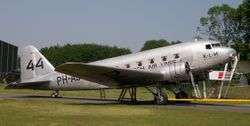
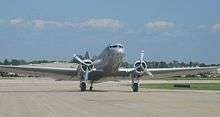
There are no longer DC-2s in commercial service; however, several aircraft have survived into the 21st century:
- c/n 1286 - Ex-Eastern Airlines and RAAF, preserved (dressed as the historic "Uiver", PH-AJU) at Albury, New South Wales as centerpiece of Uiver Memorial at Albury Airport. This is the oldest DC-2 left in the world. It was removed from its prominent position on poles in front of the Albury Airport terminal building in late 2002, but unfortunately kept out in the open air without preservation. In 2014 after much debate and delays, Albury City Council transferred ownership of the plane to the Uiver Memorial Community Trust (UMCT). In January 2016 UMCT began work on removing the major assemblies of the aircraft, and on 12 May 2016 the airframe was transferred to a restoration hangar. Restoration of this aircraft to static display standard is now under way.[48]
- c/n 1288 - Also located at the Aviodrome in the Netherlands though owned by the Dutch Dakota Association.[49] It is far from airworthy and will not be restored to such a condition. Its first operator was Eastern Air Lines.
- c/n 1292 - There are three DC-2s surviving in Australia as of 2006; this aircraft, c/n 1292, is one of ten ex-Eastern Airlines DC-2s purchased and operated by the RAAF during World War II as A30-9. It is under restoration by the Australian National Aviation Museum.[50] at Moorabbin Airport in Victoria, Australia
- c/n 1354 - One DC-2-115E (reg. DO-1 (Hanssin-Jukka), ex. PH-AKH (KLM Haan), SE-AKE) is preserved by the Aviation Museum of Central Finland (Finnish Air Force Museum) and is on display in a hangar in Tuulos, Finland.[51] The plane was restored to display condition in 2011, in war-time colors. It performed one bombing raid in February 1940. Another wingless fuselage (c/n 1562, reg. DO-3, ex. OH-LDB "Sisu") was on display at the Finnish Aviation Museum in Vantaa.[52][53] The fuselage was transported to the Aviation Museum of Central Finland in 2011, where it was used in the DO-1 restoration project.
- c/n 1368 - A former Pan Am aircraft that was used by the Douglas historical foundation until the merger with Boeing in 1997. It is now housed at the Museum of Flight in Seattle, Washington. This aircraft (N1934D) was restored to flying condition in 2007 and flown to Santa Maria, California for a new paint job. It received a TWA "The Lindbergh Line" livery and interior trim.[54]
- c/n 1376 - Owned by Steve Ferris in Sydney, Australia, and has been under restoration to flying status for many years. It was originally delivered to KNILM in 1935. At the outbreak of World War II it was flown to Australia and was conscripted into use with the Allied Directorate of Air Transport. In 1944 it joined Australian National Airways and finished its flying career in the 1950s with Marshall Airways. It is registered as VH-CDZ. It is the most complete of all the Australian DC-2s as of 2008.
- c/n 1404 - The Aviodrome in Lelystad, the Netherlands, owns and operates one of the last flying DC-2s. This former United States Navy aircraft is painted in the Uiver's KLM color scheme and is sometimes seen in European airshows. It is registered as NC39165 since 1945, though it now also wears PH-AJU as a fictional registration to match that of the historic Uiver aircraft.[49] The aircraft was operated by Mercer Airlines of Burbank, California, and sold in the late 1960s to Colgate Darden, who restored it in General Air Lines colors and moved it to his private airport in South Carolina.
- c/n 2702 - C-39A (Serial Number 38-515) is at the National Museum of the United States Air Force at Wright-Patterson AFB in Dayton, Ohio. The aircraft is currently in storage at the museum.[55][56]
Notable appearances in media
The DC-2 was the "Good Ship Lollipop" that Shirley Temple sang about in the film Bright Eyes (1934).[57] A DC-2 appears in the 1937 film Lost Horizon; the footage includes taxiing, takeoff, and landing, as well as views in flight.[58]
Author Ernest K. Gann recounts his early days as a commercial pilot flying DC-2s in his memoir Fate Is the Hunter. This includes a particularly harrowing account of flying a DC-2 with heavy ice.
Specifications (DC-2)
General characteristics
- Crew: two-three
- Capacity: 14 passengers
- Length: 62 ft 6 in (19.1 m)
- Wingspan: 85 ft 0 in (25.9 m)
- Height: 15 ft 10 in (4.8 m)
- Wing area: 940 ft² (87.3 m²)
- Empty weight: 12,455 lb (5,650 kg)
- Loaded weight: 18,560 lb (8,420 kg)
- Powerplant: 2 × Wright GR-1820-F53 Cyclone 9-cylinder radial engines, 730 hp (540 kW) each
Performance
- Maximum speed: 210 mph at 6,800ft (338 km/h / 182 kts)
- Cruise speed: 174 mph[59] (151 kn, 278 km/h)
- Range: 1,085 mi (1,750 km)
- Service ceiling: 22,750 ft (6,930 m)
- Rate of climb: 1,030 ft/min (310 m/min)
See also
Related development
Aircraft of comparable role, configuration and era
Related lists
References
Notes
- ↑ Robert Bluffield, Over Empires and Oceans
- 1 2 O'Leary, Michael. "Douglas Commercial Two." Air Classics magazine, May 2003.
- ↑ "Douglas tells secrets of speed." Popular Mechanics, February 1935.
- ↑ "DC-2 Commercial History." Archived November 20, 2010, at the Wayback Machine. Boeing. Retrieved: November 26, 2010.
- ↑ Francillon 1979, p. 180.
- 1 2 3 Francillon 1979, p. 181.
- ↑ "Air Corps flagship is flying headquarters." Popular Mechanics, January 1936.
- ↑ Francillon 1979, pp. 181–182.
- ↑ Francillon 1979, p. 182.
- ↑ Francillon 1979, pp. 182–183.
- 1 2 Francillon 1979, p. 239.
- ↑ "Transportes Navales." histarmar.com. Retrieved: August 5, 2010.
- ↑ R. Stocchetti. "Douglas DC2 - DC3, Aerei militari, Schede tecniche aerei militari italiani e storia degli aviatori".
- ↑ Francillon 1970, p. 499.
- ↑ "11-III-1935." Archived 2013-12-19 at the Wayback Machine. Llega a Barajas el primer Douglas DC-2 para las Líneas Aéreas Postales Españolas (LAPE). Retrieved: February 11, 2014.
- ↑ "De Uiver verongelukt bij Rutbah Wells (Irak)" (in Dutch). aviacrash.nl. Retrieved: December 6, 2011.
- ↑ "Major Airline Disasters: Involving Commercial Passenger Airlines 1920-2011". airdisasters.co.uk. Retrieved: February 22, 2013.
- ↑ Accident description for NC13785 at the Aviation Safety Network. Retrieved on 2014-9-11.
- ↑ "Major Airline Disasters: Involving Commercial Passenger Airlines." airdisasters.co.uk. Retrieved: February 22, 2013.
- ↑ Accident description for NC14285 at the Aviation Safety Network. Retrieved on 2017-1-21.
- ↑ Accident description for NC14273 at the Aviation Safety Network. Retrieved on 2017-1-21.
- ↑ "The Pittsburgh Press - Google News Archive Search".
- ↑ Accident description for PH-ALF at the Aviation Safety Network. Retrieved on 2014-9-11.
- ↑ Accident description for URSS-M25 at the Aviation Safety Network. Retrieved on 2017-1-21.
- ↑ Accident description for NC13739 at the Aviation Safety Network. Retrieved on 2014-9-11.
- ↑ Accident description for NC14298 at the Aviation Safety Network. Retrieved on 2014-9-11.
- ↑ Accident description for SP-ASJ at the Aviation Safety Network. Retrieved on 2014-9-11.
- ↑ Accident description for NC14272 at the Aviation Safety Network. Retrieved on 2014-9-11.
- ↑ Gregory Crouch (2012). "Chapter 13: The Kweilin Incident". China's Wings: War, Intrigue, Romance and Adventure in the Middle Kingdom during the Golden Age of Flight. Bantam Books. pp. 155&ndash, 170 (In EPub version 3.1: pp. 172&ndash, 189).
- ↑ Accident description for J-BBOH at the Aviation Safety Network. Retrieved on 2017-1-21.
- ↑ Accident description for HB-ITA at the Aviation Safety Network. Retrieved on 2012-9-11.
- ↑ Accident description for NC13237 at the Aviation Safety Network. Retrieved on 2014-9-11.
- ↑ Accident description for D-AIAV at the Aviation Safety Network. Retrieved on 2014-9-11.
- ↑ Gregory Crouch (2012). "Chapter 17: Ventricular Tachycardia,". China's Wings: War, Intrigue, Romance and Adventure in the Middle Kingdom during the Golden Age of Flight. Bantam Books. pp. 217&ndash, 220. (In EPub version 3.1: pp. 240–242)
- ↑ Accident description for 9622 at the Aviation Safety Network. Retrieved on 2017-1-23.
- ↑ Accident description for 40 at the Aviation Safety Network. Retrieved on 2014-9-11.
- ↑ Accident description at the Aviation Safety Network. Retrieved on 2014-9-11.
- ↑ Accident description for NC14729 at the Aviation Safety Network. Retrieved on 2014-9-11.
- ↑ Accident description for DG475 at the Aviation Safety Network. Retrieved on 2017-1-23.
- ↑ Accident description for 38-525 at the Aviation Safety Network. Retrieved on 2017-1-23.
- ↑ "Major Airline Disasters: Involving Commercial Passenger Airlines 1920-2011." airdisasters.co.uk. Retrieved: February 22, 2013.
- ↑ Accident description for 38-505 at the Aviation Safety Network. Retrieved on 2014-9-11.
- ↑ Accident description at the Aviation Safety Network. Retrieved on 2017-1-23.
- ↑ Accident description for 38-524 at the Aviation Safety Network. Retrieved on 2014-9-11.
- ↑ Accident description for 38-501 at the Aviation Safety Network. Retrieved on 2014-9-11.
- ↑ Accident description for XA-DOT at the Aviation Safety Network. Retrieved on 2017-1-23.
- ↑ Accident description for DO-3 at the Aviation Safety Network. Retrieved on 2014-9-11.
- ↑ "Douglas DC-2." adf-serials.com. Retrieved: November 27, 2010.
- 1 2 "Collectieoverzicht:A–F." Aviodrome. Retrieved: November 23, 2010.
- ↑ "DC-2." The Australian National Aviation Museum. Retrieved: August 5, 2010.
- ↑
- ↑ "DC-2." Finnish Aviation Museum. Retrieved: August 5, 2010.
- ↑ "Accident description, February 7, 1951." aviation-safety.net. Retrieved: August 5, 2010.
- ↑ "Douglas DC-2-118B." airliners.net. Retrieved: December 6, 2011.
- ↑ "Factsheet: Douglas C-39." Archived September 14, 2011, at the Wayback Machine. National Museum of the U.S. Air Force, November 30, 2007. Retrieved: October 19, 2011.
- ↑ "Aircraft 38-0515 Data". Airport-Data.com. Airport-Data.com. Retrieved 22 April 2015.
- ↑ Boyes, Laura. "Bright Eyes (1934)". Moviediva. Retrieved 3 March 2014.
- ↑ Photo Documentary section of the Special Features on the 1998 Columbia/Sony DVD release of the restored version.
- ↑ "DC-3/Dakota Historical Society, Inc".
Bibliography
- Francillon, René J. Japanese Aircraft of the Pacific War. London: Putnam, 1970. ISBN 0-370-00033-1.
- Francillon, René J. McDonnell Douglas Aircraft since 1920. London: Putnam, 1979. ISBN 0-370-00050-1.
- United States Air Force Museum Guidebook. Wright-Patterson AFB, Ohio: Air Force Museum Foundation, 1975.
External links
| Wikimedia Commons has media related to Douglas DC-2. |